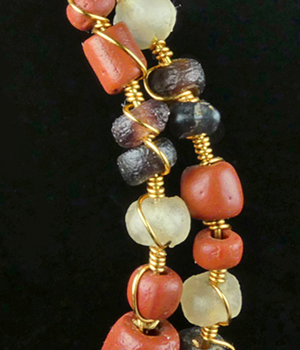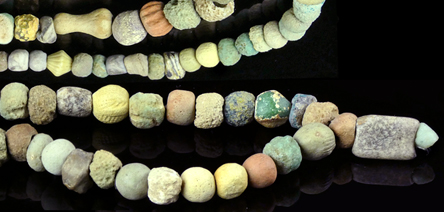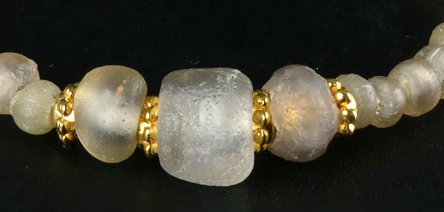- Home
- Historical info
- Beads
Beads

Care for ancient beads
The composition of ancient or Roman glass can cause it to react chemically with moisture, skin oil or cleaning liquids that touch the glass. Over time this can cause discolouration or loss of the iridescent appearance.
The following tips can help to keep the glass in excellent condition.
- Keep it dry: do not shower, swim or wear the jewellery during a heavy workout.
- Avoid contact with chemicals: perfume, soap, hand/body lotion, hairsprays etc. Put on your jewellery as the finishing touch before going out.
- After wearing gently wipe any loose dirt collected on the surface with a dry soft cloth.
- If the metal setting, hooks or clasps appear dull use a dry cloth or silver cleaning cloth to gently wipe the metal parts while avoiding the glass.
- Store the jewellery in a dark and dry place. All our jewellery is delivered in special jewellery boxes (when size permits). These have protective foam and do not contain tarnish-accelerating chemicals.
With some care your glass jewellery can continue the cycle of being passed down and treasured by future generations.
Designs and Techniques
Exclusive designs
Inspired by timeless classic designs we offer exclusive handmade jewellery with ancient and Roman beads. A variety of techniques and materials is used to bring the ancient beads back to life, resulting in a versatile selection and styles to choose from.
Our designers use ancient wire-wrapping and linking methods as well as more contemporary 'floating' technique with an optical illusion effect. New designs are created with the use of different materials such as decorative spacer beads, chains or leather cord (popular in Roman times). These can result in a classic elegant design or a more contemporary modern look.

Chain linking technique
The ancient jewellery maker created links by hammering out sheets of gold or silver and rolling it into wire. The oldest example of a chain necklace was found in ancient Babylonia in a royal tomb dating back to around 2500 BC.
The perennial loop-in-loop technique circulated in different ancient cultures. Gold and silver chain necklaces were adorned with decorative pendants,semi-precious stones or charms to protect the wearer from evil. The royalty and elite upper class embedded gemstones in the links, glass in different colours was used to imitate these precious gemstones.
Ancient wire-wrapping technique
The wire-wrapping technique dates back from ca. 2000 BC and was a favourite technique of jewellery makers in ancient civilizations. No soldering or heating was required and also had the advantage of making jewellery with cabochons or amulets by wrapping wire around the stones (no need to drill holes).
The wire can be used to wrap around beads or it can be expertly bent into loops, spirals or other decorative shapes and also allows smaller beads to be wrapped and incorporated in the design creating timeless quality jewellery designs.
Ancient & Roman beads
Every authentic ancient bead is slightly different in shape or colour shade and shows different signs of wear or the passing of time (iridescence). This adds to the charm of each piece and makes every composition unique.
Customization
We cooperate with two local Dutch designers to handcraft all our special designs. This makes it possible to customize some of our existing designs (longer/shorter) or offers the possibility of creating a new design according to your personal preferences.
Contact us to discuss the options.
History of beads
Beads are one of the earliest forms of decoration known to man. Simple beads were made of materials that were available: pierced teeth, bone, shell or stones. Beads are often worn as amulets for good luck or as protection from evil forces.
About 3500 years ago ancient beadmakers in Egypt and Mesopotamia experimented with glazing steatite and making faience. They succeeded in creating glass with three simple components: sand quartz, soda ash and limestone. Various colours could be produced by adding minerals as iron, copper, manganese, cobalt or gold.

The Romans learned the glass-making craft after the conquest of Egypt in the 1st century BC. During the 1st century AD the glassblowing technique revolutionized the production and made it possible to produce larger quantities. By adding manganese dioxide Roman glassmakers successfully produced colourless or ‘aqua’ glass for the first time.
Roman glass became a very popular material, used for beads, glass windows, mosaic tiles, tableware pieces etc. Roman glass was traded all over the Roman Empire and far beyond to Central Africa, Scandinavia and via the Silk Route to China.

Information
General information
All our glass beads jewellery will be delivered in a jewellery box to allow for safe storage and secure protection during shipping (when size permits). The jewellery boxes have protective foam and do not contain tarnish-accelerating chemicals.
Contemporary materials
All our beaded jewellery is restrung with contemporary professional stringing material and fasteners to make it wearable or to facilitate putting it on display. All spacer beads, hooks, fasteners, etc. are European quality and gold- or silver-plate nickel-free metal.
Certificate of Authenticity is available upon request (pdf-format) for all the beaded jewellery items offered on this website.
